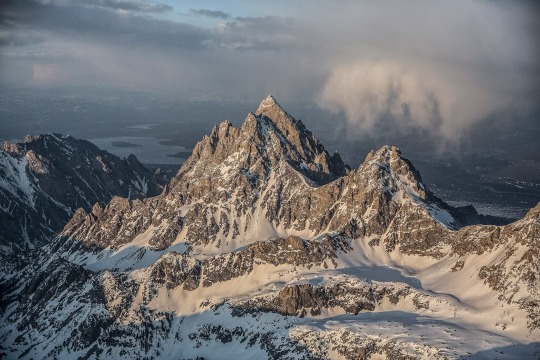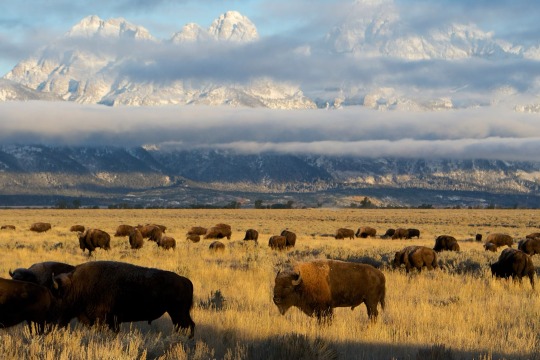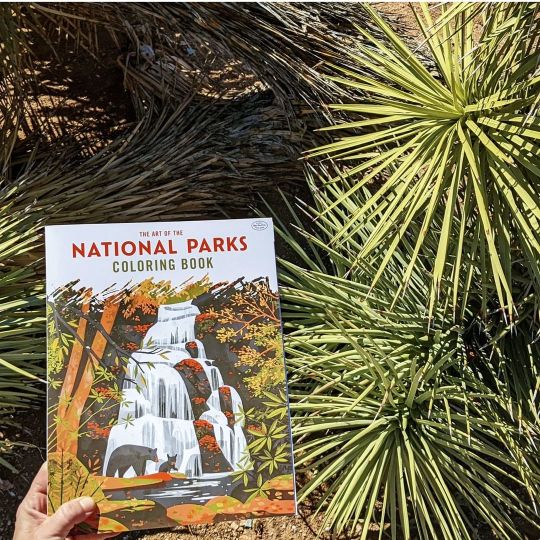#Grand Teton National Park 🏞️
Text

Fly fishers walk toward a stream in Grand Teton National Park, Wyoming, as the jagged mountains for which the park is named rise in the distance. Grand Teton draws both adventurers, for activities like mountain climbing and backcountry skiing, and leisure travelers, for boating, hiking, and fishing. Photograph By Aaron Huey, National Geographic Image Collection
How to visit Grand Teton National Park!
With Soaring Mountains and Braided Rivers, this Wyoming Park Epitomizes the American West. Here’s What You Need to Plan the Ultimate Trip.
— May 09, 2023
Fast Facts:
Location: Wyoming
Established: February 26, 1929
Size: 310,000 acres
Annual Visitors: About 2.8 million in 2022
Visitor Centers: All four are open from spring to fall; check the website for specific dates. Every center except the Laurance S. Rockefeller Preserve Center issues backcountry and boat permits. Flagg Ranch Information Station is a helpful trip planning stop, when entering from the south end of Yellowstone National Park.
Entrance Fee: Per vehicle and individual; annual passes available
Sharpened by glaciers, Grand Teton National Park’s snow-etched mountains erupt above Jackson Hole valley, composing one of the most iconic views in the country. “The Tetons rise to over 13,000 feet in a matter of miles. Just seeing that makes you feel humble,” says Vasu Sojitra, a professional athlete and disability access advocate, who completed the first disabled ascent on crutches of the Grand Teton in 2014.

The towering granite crags of the Grand Teton range have drawn mountaineers, hikers, and photographers to this Wyoming park. Photograph By Jimmy Chin, National Geographic Image Collection


Left: Clouds drift above a herd of bison grazing in a valley in Grand Teton National Park. Visitors can also spot moose, bald eagles, ospreys, and pikas. Photograph By Barrett Hedges, National Geographic Image Collection. Right: In the fall, quaking aspen trees bring golden color to Grand Teton National Park. Photograph By Tom Murphy, National Geographic Image Collection
Some 200 years ago these majestic mountains were called Pilot Knobs by fur trappers because they could be seen from miles away. One of the Tetons’ tallest peaks, Teewinot, meaning “many pinnacles” in the Shoshone language, references the region’s ancestral roots. The 1800s homesteading tradition in the nearby town of Jackson gives the valley its moniker “The Last of the Old West.” Gazing out at verdant plains, towering crags, and fields of lemon-yellow balsamroot blooms, visitors understand why the park has become an emblem of the American West.
Why Go
Adventure athletes travel to the park to climb historic mountaineering routes, backpack into wildflower-strewn basins, or ski down advanced backcountry slopes in winter. But the park is also ideal for leisurely activities like biking, photography, and canoeing—set against the backdrop of the meandering Snake River, numerous lakes and streams, and the Grand Teton range.

Although a fraction of the size of nearby Yellowstone National Park, Grand Teton offers equally dramatic mountain vistas and impressive wildlife viewing. Outdoor photographer and Jackson local Steven Shelesky says it’s common to see wildlife, including elk, moose, pronghorn, and bison, while simply driving through the park.
Best Views
Shelesky says getting up early to catch a sunrise in the park is well worth the effort. “The entire Teton range is east facing, which makes for an amazing spectacle,” he says. Located about 350 yards from the parking lot, Schwabacher Landing offers particularly memorable views of a beaver pond off the Snake River. “You can see beautiful reflections of the Grand Teton on the water’s surface,” says Shelesky.

Sunset casts a rosy glow on the Snake River, in Grand Teton National Park, where families can go on scenic rafting tours. Photograph By Keith Ladzinski, National Geographic Image Collection
Nearby, the Snake River Overlook is another vista Shelesky recommends. The famous viewpoint captured by photographer Ansel Adams in 1942 highlights the curving river framed by the towering Tetons. Look for the Snake River Overlook turnout sign off Highway 191/89.
Best Hikes
Beginning at the Taggart Lake Trailhead on Teton Park Road, Taggart Lake is an easy hike that leads to a gorgeous lakeside picnic spot, where the Tetons reflect in the water. The three-mile round-trip trail rises just over 300 feet as it crosses bridges and weaves through a grove of quaking aspen trees, whose leaves tremble at the slightest breeze. For a more moderate hike, it’s well worth the extra steps to tack on the Taggart Lake-Bradley Lake Loop, which takes you 5.6 miles to both lakes. Both trails are also popular snowshoeing routes in winter.
Hikers looking for a more challenging route can follow the roaring Cascade Creek up the Forks of Cascade Canyon trail, where the glacially carved landscape leads to numerous viewpoints, including Inspiration Point and Hidden Falls. The 9.8-mile out-and-back route can be made more challenging during the day or as part of an overnight trip (permits required), by trekking 14.1 miles to Lake Solitude. You can book a round-trip ticket on the Jenny Lake Shuttle Service to avoid hiking an extra four miles roundtrip.
Best Drives
Teton Park Road and Highway 191/89/26 make a 42-mile loop that takes you to several pullouts and viewing sites in the park. Signal Hill Mountain Summit Road winds to the top of Signal Hill (nearly a thousand feet), where you’ll find two overlooks of the plunging Jackson Hole valley. The narrow road is five miles long and closed during winter.
Wildlife Spotting
Whether you’re on the slopes of Mt. Moran or canoeing Jackson Lake, wildlife abounds in Grand Teton National Park. Find elk and pronghorn in the sharp sagebrush of Timbered Island, just south of the Jenny Lake Visitor Center. Bison and moose roam the woods near various overlooks including Oxbow Bend along the Snake River, while bald eagles and osprey circle the sky.
Climb up the glacially carved Cascade Canyon trail and look for yellow-bellied marmots as you listen for the high-pitched chirp of pikas, a small lagomorph related to rabbits and hares. You just might see them collecting wildflowers and grass, which they store in hay piles for cold, snowy winters.
One of the park’s greatest attributes is its wildlife. To ensure your safety and theirs, obey the law requiring visitors to stay at least a hundred yards from bears and wolves and 25 yards from all other wildlife, including bison, moose, and pronghorn.
Posted speed limits are especially important in Grand Teton, which has seen increased wildlife collisions since 2000. Park officials advise extra caution during the fall, when animals migrate, and during low-light hours at dawn, dusk, and nighttime, when the speed limit is 45 miles per hour.
Visit Like a National Geographic Explorer
Wildlife biologist and National Geographic Explorer Autumn Iverson recommends getting an early start in Grand Teton. “Early in the morning is when birds and other wildlife are going to be more active,” says Iverson, whose work focuses on Brewer’s sparrows, a small songbird with a distinct call that lives in sagebrush. During her many field trips at dawn, she often saw elk, moose, and pronghorn, the second fastest land animal in the world.

Top: Researchers count lodgepole pine seedlings near Flagg Ranch, where the 2016 Berry Fire—the largest in national park history—burned forests that were about 150 years old. Photograph By Sofia Jaramillo, National Geographic Image Collection. Bottom: Ski mountaineers trek up the crest on Mount Owen in Grand Teton National Park. Outfitters such as Exum Mountain Guides and Jackson Hole Mountain Guides lead visitors up into the Tetons in winter and summer. Photograph By Jimmy Chin, National Geographic Image Collection

Jackson Lake glimmers like a black-and-white photograph in the winter. The lake is a popular spot for ranger-led programs, wildlife spotting, and canoeing. Signal Mountain Lodge is located on these shores.

Jackson Lake glimmers like a black-and-white photograph in the winter. The lake is a popular spot for ranger-led programs, wildlife spotting, and canoeing. Signal Mountain Lodge is located on these shores. Photograph By Michael K. Nichols, National Geographic Image Collection
Iverson says she particularly enjoyed paddling one of the many lakes. That’s when “you get this whole expansive view of everything around you,” she says. Visitors can rent canoes or kayaks from Signal Mountain Marina and the Colter Bay Marina, among other outfitters. Paddling is generally recommended in the morning before afternoon winds arrive.
Activities and Excursions
The Tetons are a steep mountain range that have attracted mountaineers and climbers like Irene Ortenburger and Yvon Chouinard. Because of their steep pitch and high elevation, many of the park’s high-altitude trails may be inaccessible for the first-time hiker.
Experienced hikers are drawn to the park for its challenging backpacking routes, including the sought-after Teton Crest Trail, which follows the range’s spine through wildflower-filled peaks from Teton Pass to String Lake. Totaling 40 miles, the trail generally takes backpackers three to five days to complete. Apply for a permit six months in advance on Recreation.gov.
Ambitious hikers and mountaineers may opt for a multiday trip in the backcountry to make summit attempts on the coveted 13,775-foot Grand Teton. Exum Mountain Guides and Jackson Hole Mountain Guides lead visitors up the lofty peaks in summer and offer ski mountaineering trips throughout the winter.
Best For Families
From mid-June to September, the park puts on various complimentary interpretive programs, which generally occur at Jackson Lake Lodge, Colter Bay Village, and Headwaters Lodge and Cabins. Jackson Lake Lodge’s naturalist programs illuminate the world of wildlife in the park, including birds of prey, mountain lions, and grizzly bears. Ranger-led hikes, wildlife viewing, and campfire talks occur daily in the summer throughout the park at its many visitor centers. Check the event calendar for the latest listings.
Outfitters like Solitude Float Trips or National Park Float Trips guide families on scenic rafting tours on the Snake River. Rafts generally put in at Deadmans Bar and take two to three hours to float 10 miles to Moose Landing, passing through a mellow stretch of the river. Knowledgeable guides educate guests on the park’s history and point out fauna, including white pelicans, beavers, and bison. Fall can be particularly picturesque, when rafts float by quaking aspen trees studded with golden leaves and stately Colorado blue spruce.
Where To Stay
There are eight campgrounds and seven lodges within the park’s boundaries. Stay on the glimmering shores of Jackson Lake at the upscale Signal Mountain Lodge or find a more rustic option at American Alpine Club Grand Teton Climbers’ Ranch, which hosts communal cabins popular with climbers and other outdoor enthusiasts. The National Park Service lists more options on its website.
Campers have over a thousand sites to choose from, ranging from $10 to just over $100 per night. Book six months in advance through Recreation.gov. Colter Bay Tent Village has 66 “tent cabins” with wood walls and canvas tent roofs. The small cabins include covered porches, bunk beds, and wood-burning stoves.
Note that all lodges, cabins, and campsites within the park close during the winter, but there are plenty of options in the bustling town of Jackson. About 13 miles from the park’s Moose entrance, Jackson has numerous restaurants, historic hotels, and live music venues.
You can also find lodging in Teton Village at the base of Jackson Hole Mountain resort. The charming area is just under two miles from the park’s southern Granite Canyon entrance, making it a great basecamp for skiers.

The Milky Way glitters over the Grand Teton mountain range, in Wyoming. Photograph By Babak Tafreshi, National Geographic Image Collection
Need to know
The park is located in northwest Wyoming near the border of eastern Idaho, accessible via three entrances: Granite Canyon, Moose, and Moran Junction. Since Grand Teton is connected to Yellowstone National Park by the John D. Rockefeller, Jr. Memorial Parkway, most visitors tack Grand Teton onto a multiday trip to Yellowstone.
July and August are the most popular times to visit Grand Teton. May, September, and October see fewer crowds and cooler temperatures. Although wintertime shuts down many amenities and roads, it’s a great time to experience the region by snowshoe, cross-country skis, or snowmobile.
Spring can be an especially nice time to visit when portions of Teton Park Road open for a short time to cyclists, inline skaters, and other recreationists before cars are permitted in May. Before your trip, check the park’s alerts and current conditions page for road closures.
General Tips
Weather changes quickly in the Rocky Mountains, especially in the summer. Always pack extra layers and a rain jacket on all outdoor excursions. When venturing into the high country, start early so you can get below the treeline by noon, thereby avoiding afternoon thunderstorms, which can be violent.
Grand Teton National Park is black and grizzly bear country. The National Park Service recommends hikers carry bear spray, a non-lethal deterrent that’s EPA-approved.
Accessibility
While some visitor centers, campsites, and lodges are accessible, there aren’t many trails for wheelchair and other medical aid users, says Vasu Sojitra, the disability access advocate. He notes that the North Pathway, a 20-mile paved trail that connects Jackson, Wyoming, with the park at Jenny Lake, is one of the more accessible areas in the region. “It is a really great way to experience and make a bigger day out of visiting the park,” he says.
#United States 🇺🇸#National Parks 🏞️#Grand Teton National Park 🏞️#National Geographic#Rocky Mountains ⛰️#Ultimate Trip#American 🇺🇸 West
4 notes
·
View notes
Photo

🏜️ I'm grateful to live close to one of the most beautiful national parks! I love the feature about the Joshua Tree National park in this new edition of The Art of the National Parks Coloring Book! Thanks so much to our friends @fiftynineparks and @insighteditions for sending us a copy! 🏞️ The Art of the National Parks Coloring Book features poster-sized and stylized line art renderings from the popular “Fifty-Nine Parks print series.” Using a contemporary take on the famous W.P.A. posters of the 1930s, each coloring image is an #originalrendition of the artist’s unique perspective on a #park, resulting in #oneofakind illustrative tributes to the majesty of each #nationalpark. Art includes all 63 US National Parks, including the Great Smoky Mountains, Yellowstone, Zion, Rocky Mountain, Grand Teton, #GrandCanyon, Cuyahoga Valley, Acadia, Olympic, and my favorite #JoshuaTree. Each poster contains a full-color image of the park at the back of the book to provide #inspiration and direction for your choice of colors to use. To learn more and order your copy visit https://amzn.to/3dExTGn Or https://insighteditions.com/products/the-art-of-the-national-parks-coloring-book . . . . . . . . . . . . #adultcoloringbook #organizedmom #organization #getorganized #organized #organizedmoms #organizedlife #productreviewer #amazonreviewer #coloringbook (at Yucca Valley, California) https://www.instagram.com/p/Ci0nniev_qm/?igshid=NGJjMDIxMWI=
#originalrendition#park#oneofakind#nationalpark#grandcanyon#joshuatree#inspiration#adultcoloringbook#organizedmom#organization#getorganized#organized#organizedmoms#organizedlife#productreviewer#amazonreviewer#coloringbook
0 notes